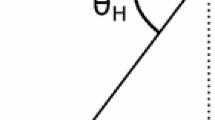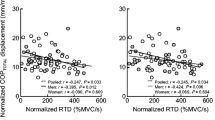Abstract
Lower limb explosive power, which is more predictive of functional difficulties than strength per se with women being more at risk than men for disability, has been previously compared between young and older women using systems with fixed inertia. Individuals may have been obliged to use a percentage of their maximum strength that is not ideal for performing the movement at the optimum speed for maximum power output. This study was designed to compare explosive power output and its two determinants, optimal force and optimal speed, during a leg-press action between young and older women after optimising the load for maximum power production. The experiments were carried out on 20 women in good physical condition: 10 older, aged between 65 and 74 years and 10 young, aged between 18 and 30. Explosive power output was measured by setting the initial load at different percentages of maximum isometric strength and measuring the corresponding speed of movement during a leg-press action of the dominant leg. Maximum peak power, which was obtained at 60% of maximum isometric strength in both young and older women, was 61% lower in the older women (P<0.0001). This was due to a 52% lower optimal force (P<0.0001) and 21% lower optimal speed (P<0.01). The ratio of peak power to maximum isometric strength was 22.1% lower in the older women (P<0.01). After optimising the load, both lower speed of movement and lower strength determine the lower levels of power in older women. Power is more affected by ageing than isometric strength.




Similar content being viewed by others
References
Bassey EJ, Short AH (1990) A new method for measuring power output in a single leg extension: feasibility, reliability and validity. Eur J Appl Physiol 60:385–390
Bassey EJ, Fiatarone MA, O'Neill EF, Kelly M, Evans WJ, Lipsitz LA (1992) Leg extensor power and functional performance in very old men and women. Clin Sci 82:321–327
Bosco C, Komi PV (1980) Influence of ageing on the mechanical behaviour of leg extensor muscles. Eur J Appl Physiol 45:209–219
Davies CTM, White MJ, Young K (1983) Electrically evoked and voluntary maximal isometric tension in relation to dynamic muscle performance in elderly male subjects, aged 69 years. Eur J Appl Physiol 51:37–43
De Vito G, Bernardi M, Forte R, Pulejo C, Macaluso A, Figura F (1998) Determinants of maximal instantaneous muscle power in women aged 50–75 years. Eur J Appl Physiol 78:59–64
Delbono O, Renganathan M, Messi ML (1997) Excitation-Ca2+ release-contraction coupling in single aged human skeletal muscle fibre. Muscle Nerve 20:S88–S92
Ferretti G, Narici MV, Binzoni T, Gariod L, Le Bas JF, Reutenauer H, Cerretelli P (1994) Determinants of peak muscle power: effects of age and physical conditioning. Eur J Appl Physiol 68:111–115
Fiatarone Singh MA (2000) Exercise and aging. In: Fiatarone Singh MA (ed) Exercise, nutrition, and the older woman: wellness for women over fifty. CRC, London, pp 3–36
Foldvari M, Clark M, Laviolette LC, Bernstein MA, Kaliton D, Castaneda C, Pu CT, Hausdorff JM, Fielding RA, Fiatarone Singh MA (2000) Association of muscle power with functional status in community-dwelling elderly women. J Gerontol 55A:M192–M199
Frontera WR, Suh D, Krivickas LS, Hughes VA, Goldstein R, Roubenoff R (2000) Skeletal muscle fiber quality in older men and women. Am J Physiol 279:C611–C618
Fukunaga T, Roy RR, Shellock FG, Hodgson JA, Edgerton VR (1992) Physiological cross-sectional area of human leg muscles based on magnetic resonance imaging. J Orthop Res 10:926–934
Grassi B, Cerretelli P, Narici MV, Marconi C (1991) Peak anaerobic power in master athletes. Eur J Appl Physiol 62:394–399
Greig CA, Young A, Skelton DA, Pippet E, Butler FMM, Mahmud SM (1994) Exercise studies with elderly volunteers. Age Ageing 23:185–189
Harridge SDR, Young A (1998) Skeletal muscle. In: Pathy MJS (ed) Principles and practice of geriatric medicine. Wiley, London, pp 898–905
Hicks AL, Cupido CM, Martin J, Dent J (1992) Muscle excitation in elderly adults: the effects of training. Muscle Nerve 15:87–93
Höök P, Vidyasagar S, Larsson L (2001) Effects of aging on actin sliding speed on myosin from single skeletal muscle cells of mice, rats, and humans. Am J Physiol 280:C782–C788
Hunter SK, Thompson MW, Ruell PA, Harmer AR, Thom JM, Gwinn TH, Adams RD (1999) Human skeletal sarcoplasmic reticulum Ca2+ uptake and muscle function with aging and strength training. J Appl Physiol 86:1858–1865
Izquierdo M, Ibanez J, Gorostiaga E, Garrues M, Zuniga A, Anton A, Larrion JL, Häkkinen K (1999) Maximal strength and power characteristics in isometric and dynamic actions of the upper and lower extremities in middle-aged and older men. Acta Physiol Scand 167:57–68
Klitgaard H, Ausoni S, Damiani E (1989) Sarcoplasmic reticulum of human skeletal muscle: age-related changes and effect of training. Acta Physiol Scand 137:23–31
Klitgaard H, Mantoni M, Schiaffino S, Ausoni S, Gorza L, Laurent-Winter C, Schnohr P, Saltin B (1990) Function, morphology and protein expression of ageing skeletal muscle: a cross-sectional study of elderly men with different training backgrounds. Acta Physiol Scand 140:41–54
Larsson L, Grimby G, Karlsson J (1979) Muscle strength and speed of movement in relation to age and muscle morphology. J Appl Physiol 46:451–456
Larsson L, Xiaopeng L, Frontera WR (1997) Effects of aging on shortening velocity and myosin isoform composition in single human skeletal muscle cells. Am J Physiol 272:C638–C649
Lexell J, Taylor AW, Sjostrom M (1988) What is the cause of the aging atrophy? Total number, size and proportion of different fiber types studied in whole vastus lateralis muscle from 15- to 83-year-old men. J Neur Sci 84:275–283
Macaluso A, Nimmo MA, Foster JE, Cockburn M, McMillan NC, De Vito G (2002) Contractile muscle volume and agonist-antagonist coactivation account for differences in torque between young and older women. Muscle Nerve 25:858–863
Maganaris CN (2001) In vivo tendon mechanical properties in young adults and healthy elderly [Online]. http://www.mmu.ac.uk/c-a/exspsci/research/invivo.htm
Metter EJ, Conwit R, Tobin J, Fozard JL (1997) Age-associated loss of power and strength in the upper extremities in women and men. J Gerontol 52A:B267–B76
Morgan M, Phillips JG, Bradshaw JL, Mattingley JB, Iansek R, Bradshaw JA (1994) Age related motor slowness: simply strategic? J Gerontol 49A:M133–M139
Narici MV (1999) Effect of ageing on muscle contractile properties. In: Narici MV, Capodaglio P (eds) Physical activity in the elderly. Maugeri Foundation Books and PI-ME Press, Pavia, pp 61–67
Narici MV, Bordini M, Cerretelli P (1991) Effect of aging on human adductor pollicis muscle function. J Appl Physiol 71:1277–1281
Norris AH, Shock NW, Wagman IH (1953) Age changes in the maximum conduction velocity of motor fibers of human ulnar nerves. J Appl Physiol 5:589–593
Pearson SJ, Harridge SDR, Grieve DW, Young A, Woledge RC (2001) A variable inertial system for measuring the contractile properties of human muscle. Med Sci Sports Exerc 33:2072–2076
Pearson SJ, Young A, Macaluso A, De Vito G, Nimmo MA, Cobbold M, Harridge SDR (2002) Muscle function in elite master weightlifters. Med Sci Sports Exerc 34:1199–1206
Rahmani A, Viale F, Dalleau G, Lacour JR (2001) Force/velocity and power/velocity relationship in squat exercise. Eur J Appl Physiol 84:227–232
Roos MR, Rice CL, Connelly DM, Vandervoort AA (1999) Quadriceps muscle strength, contractile properties and motor unit firing rates in young and old men. Muscle Nerve 22:1094–1103
Sale DG (1991) Testing strength and power. In: Mac Dougall J, Wenger H, Green H (eds) Physiological testing of the high performance athlete. Human Kinetics, Champaign, Ill., pp 21–103
Skelton DA, Greig CA, Davies JM, Young A (1994) Power and related functional ability of healthy people aged 65–89 years. Age Ageing 23:371–377
Vandervoort AA (2002) Aging of the human neuromuscular system. Muscle Nerve 25:17–25
Vandervoort AA, McComas AJ (1986) Contractile changes in opposing muscles of the human ankle joint with aging. J Appl Physiol 61:361–367
Author information
Authors and Affiliations
Corresponding author
Rights and permissions
About this article
Cite this article
Macaluso, A., De Vito, G. Comparison between young and older women in explosive power output and its determinants during a single leg-press action after optimisation of load. Eur J Appl Physiol 90, 458–463 (2003). https://doi.org/10.1007/s00421-003-0866-7
Accepted:
Published:
Issue Date:
DOI: https://doi.org/10.1007/s00421-003-0866-7




